ANA GONZÁLEZ and JOSE POZO, EUROPEAN PHOTONICS INDUSTRY CONSORTIUM (EPIC)
Optical fiber has changed the world by providing millions of kilometers of telecommunication fiber that have transformed how we communicate. But beyond telecommunications, optical fibers are making enormous impacts on both sensing applications and high-power lasers.
The requirements imposed by these non-telecom applications have resulted in a new subset of custom-tailored optical fibers — their material and structural properties are modified to render new properties and characteristics. The use of these fibers as sensing elements offers different advantages — speed, low cost, small size, integration into existing equipment, and electromagnetic interference immunity — compared to electrical and mechanical detection systems.
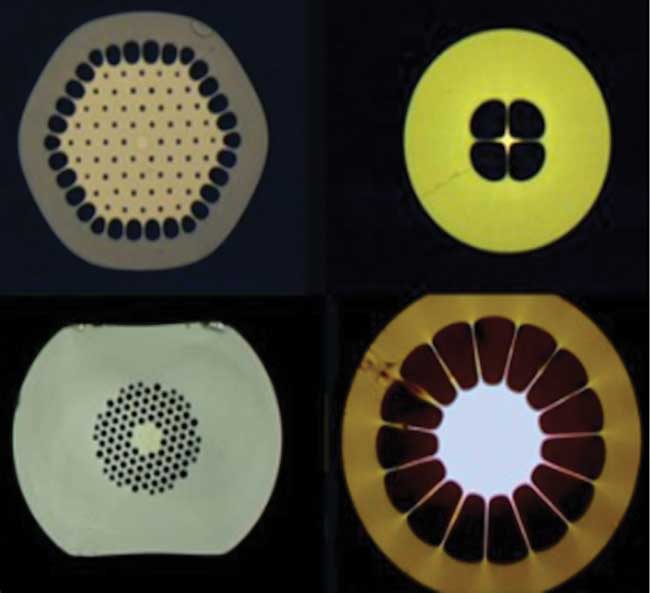
Figure 1. Different tailored optical fibers. Courtesy of Leibniz Institute of Photonic Technology/IPHT Jena.
Most types of fiber sensors are linear sensors. Measurements are done along the optical sensor cable, not at points but as a continuous profile. In addition, specialty fibers can be used in harsh environments or hazardous applications in the oil and gas industry, as well as in mining, electric utility, marine and other settings. The potential applications that specialty fibers can fulfill have pushed the fiber processing industry, in turn driving considerable progress in laser techniques (such as those used in CO2 laser systems) and 3D printing (using a femtosecond laser at 1030 nm); these are achieving high reproducibility and precision.
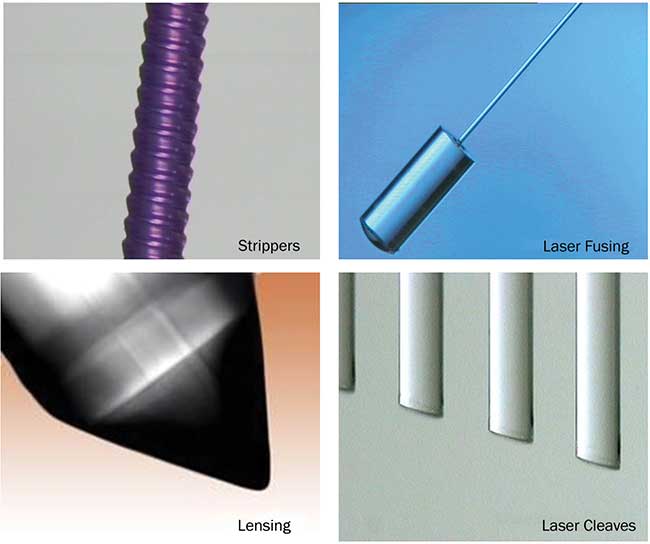
Figure 2. Depiction of the laser processing of optical fibers. Courtesy of OpTek Systems.
Currently, an extreme structural variety of optical fibers (Figure 1) such as microstructured, graded index and multicore optical fibers, among others, can be fabricated. In addition, a considerable number of fiber customizations — splicing, tapering, polishing and lensing — can be developed (Figure 2). Maintaining the desired level of optical performance across transition between two fibers is key in the implementation of fibers in the sensing field; it is crucial for small-core fibers and those lacking cylindrical symmetry in which polarization should be maintained. For that, highly specialized connectors that can be operated by active angular orientation via image processing have been developed (Figure 3).
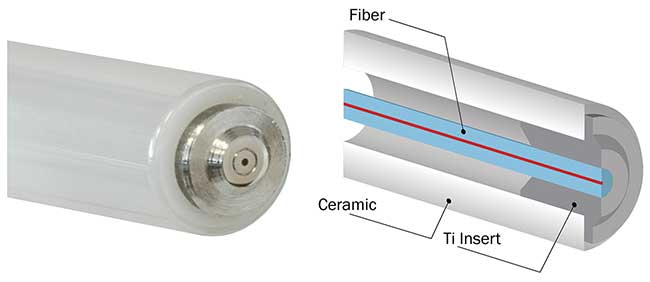
Figure 3. Optical fiber connector for active core alignment. Courtesy of Diamond SA.
Specialty fiber sensors
Common applications of distributed temperature sensing (DTS) systems are pipeline monitoring (i.e., oil or gas), oil well monitoring and fire detection systems. DTS systems work by the Raman scattering effect in which Stokes and anti-Stokes bands are affected differently based on temperature changes (Figure 4). A high accuracy of temperature determination is achieved over distances greater than 30 km.
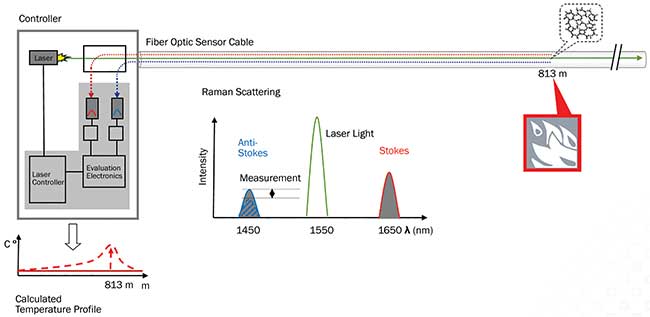
Figure 4. This illustrative scheme shows the working principle of a fire detection system based on a DTS Raman scattering effect. The heating of the fiber increases the lattice vibration, which leads to a change in backscatter behavior. Courtesy of LIOS Technology Inc.
Fiber Bragg grating (FBG) sensors introduce periodic changes to the index of refraction in the core of a single-mode optical fiber. These structures only reflect certain wavelengths, such as those satisfying the Bragg relation, which will change with function of temperature and/or strain. FBG sensors can be used as direct sensing elements for strain and temperature, as well as for chemical sensors. For chemical sensing, the grating is covered by an absorbent coating that will react to the gas, generating a strain that can be measured by the grating.
Fiber interferometers are based on the interference between two beams that propagate through different optical paths of a single fiber or two different fibers. Fiber sensors using interferometric configurations achieve a large dynamic range, high accuracy and the highest sensitivity, so they are suitable for biomedical sensing applications (Figure 5).
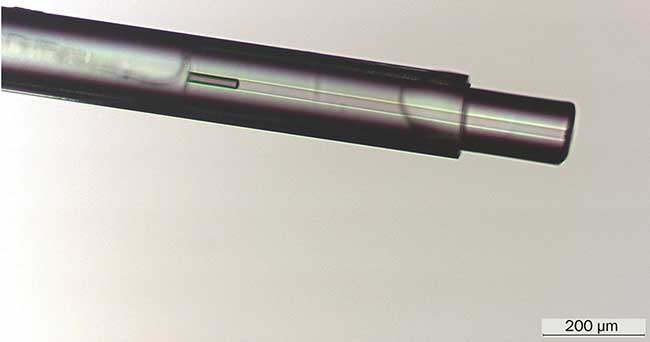
Figure 5. A fiber capillary-based sensor for medical applications, which works by Fabry-Pérot interferometry. Courtesy of Haute Ecole Arc Ingenierie.
Distributed acoustic sensing, on the other hand, relies on Rayleigh backscatter light from small variations in the refractive index of the fiber. This technique allows measuring almost simultaneously in all sections of the fiber over distances of up to 50 km from each laser source.
Finally, Brillouin scattering-based sensors are grounded in the interaction between light and acoustic phonons traveling in the fiber. Light frequency is shifted by the Doppler effect, generating light at above (anti-Stokes shift) and below (Stokes) the original optical frequency. By measuring along the fiber, it is possible to sense temperature, strain and vibrations over hundreds of kilometers.
At EPIC, we have seen the specialty fiber market growing at quite an amazing rate. New classes of specialty optical fibers are making an impact, and commercial inroads, in fields such as industrial sensing, biomedical systems, military gyro sensors and automotive lighting.
According to a February 2017 market study — for the South Australia Department of State Development — by Robert Lieberman, David Krohn and Alexis Mendez, the conservative global market size for specialty fibers in 2012 was estimated at $624 million, and is now approaching $850 million. With the advent of new markets, such as fiber-remote infrared spectroscopy and high-power systems by fiber lasers, this segment is expected to grow substantially over the next decade. Such an increase is prompted by growth of distributed fiber optic sensors for oil and gas applications.
Remarkably, the sudden drop in oil prices in 2014 did not affect that growth, mainly because of the increase in the military and security market segments. A robust growth in fiber sensors is expected by 2020 in other market segments, including chemical sensing and medical devices. Market analysts expect continued growth in the specialty fiber market, namely in the fiber processing and alignment industries. Undoubtedly, new sensing devices based on fiber optics will highly impact new applications and should engender considerable progress industrywide, as well as in the security, health care and environment fields.
Meet the authors
Ana González is a project leader at the European Photonics Industry Consortium (EPIC). Her expertise lies in the development of systems based on integrated photonic circuits, packaging and assembly, and the investigation of applications such as chemical/biological sensing and Datacom. In addition, she has been involved in technology transfer and business development processes. She received a bachelor’s degree in chemistry from the University Autonomous of Barcelona and a Ph.D. from the Catalan Institute of Nanoscience and Nanotechnology.
Jose Pozo is the director of technology and innovation at EPIC. He has 15 years’ background in photonics technology and market knowledge, and a large network within the industrial and academic photonics landscape. Jose is a member of the board of the IEEE Photonics Society Benelux. He holds a Ph.D. in electrical engineering from the University of Bristol in England and a M.Sc. and B.Eng. in telecom engineering.
Acknowledgment
EPIC wishes to thank its members who constantly share their vision and ambitions; in particular, for this article we would like to acknowledge the companies that participated in the EPIC Technology Workshop on Specialty Fibers, as well as Advanced Fiberoptics Engineering, AMS Technologies, Art Photonics, Axon Cable, CEA Tech LIST, Convergent Photonics, Diamond SA, Ed Fagan Europe, EOLITE Systems, FBGS, FEMTOprint, ficonTEC Service, GOA-Tech, Haute Ecole Arc Ingénierie, LIOS Technology, Micron Optics, NKT Photonics, NorthLab Photonics, NYFORS, OFS, Oplatek, OpTek Systems, University of Southampton, RISE Acreo, RTRC, Smart Fibers, SQS Vlaknova optika, SWISSPHOTONICS, Sylex, Technobis, and ThinkOptik.